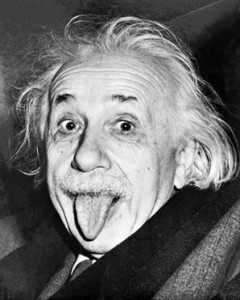A Monday night in front of the goggle box isn’t really up to much when it comes to free-to-air viewing.
 Last nights options on One included reality TV show Medical Emergency, following by the admittedly good The Missing (judging by last week’s episode) and the jaded crime show Law and Order.
Last nights options on One included reality TV show Medical Emergency, following by the admittedly good The Missing (judging by last week’s episode) and the jaded crime show Law and Order.
TV2 turned out the ghastly My Home My Castle and chick favourite Desperate Housewives, while TV3 was written off with the Monday night movie – X-Men: The Last Stand. C4 and Prime weren’t up to much which was just fine because The History Channel had a fantastic science-themed line-up that kept me watching much longer than I should have.
The prime-time viewing kicked off with Brain Story (available online), a fascinating look at neuroscience. Then we had a special on Einstein, focusing on the hugely competitive race to prove one way or other the genius scientist’s theory of general relativity.
That well-make doco was followed by part 1 in the series The Genius of Charles Darwin, in which Richard Dawkins gives us the background to the work that went into creating Darwin’s epic On The Origin of Species.
If that wasn’t enough, and for me it clearly wasn’t, there was Ancient Death Machines – a look at the ancient tools of war employed by the Greeks, Romans, Macedonians and the Chinese, who apparently were using grenades and landmines thousands of years ago.
Wired editor Chris Anderson gained fame a few years back when he came up with the theory of the longtail – where, according to Wikipedia, companies “sell a large number of unique items, each in relatively small quantities”. The idea is that numerous niches can be exploited to make viable businesses away from the mainstream. Sky TV employs this model but subverts it somewhat. Rather than paying for individual niche channels like The History Channel and Discovery (I wish), Sky makes me buy a bundled subscription that entitles us to a collection of channels, many of which (E!, Food Television) I never watch.
So its niche viewing with a mainstream price and business model. But that is changing. All of the documentaries mentioned above are available for playback on the web for free (mainly via Youtube and Google Video). They may not have been there when they premiered in the US or the UK but increasingly, they will be debuting on the web alongside free-to-air TV. This is already happening in the UK through the BBC’s iPlayer service.
As the quality of video over broadband improves and people start watching video as a data stream sent over a broadband line to their games console, set-top box or direct to the TV (TiVo will test this model here later in the year), the whole concept of prime-time viewing will change. You’ll watch whatever you want and likely make smaller, one-off payments to get the programming you want. That will be true longtail TV viewing and promises to breathe new life into a medium littered with bad reality TV shows and carbon-copy dramas.
One thing Youtube now helps you link up a laptop or PC to your TV screen to watch their videos via a special website with a supersized interface – newer TV models have the digital connections built in for this. The site is: http://www.youtube.com/xl.
A couple of days ago, I was forced to watch TV when my net connection went down for 12 hours. I had to wait until 6 oclock to get my news, then I was forced to consume whatever a small bunch of people told me to watch at a time they selected. It was a huge loss of control and felt so completely inefficient for a person like me, used to clicking on what I want, when I want, online.